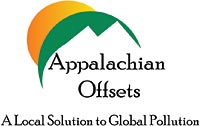Appalachian Offsets: A grassroots version of carbon trading
As consumers and businesses try to lessen their environmental impact, pursuing “carbon neutrality” is growing increasingly popular. Attaining zero-emissions status begins by calculating one’s own “carbon footprint”—the amount of carbon dioxide generated by day-to-day activities—then “offsetting” the rest. Offsetting typically means writing a check to a third party that puts the money toward a renewable-energy project elsewhere, to make up for the emissions that just can’t be helped. But because so many programs funded by carbon offsets are invisible to the consumer, the path toward carbon neutrality can be riddled with pitfalls.

“In the absence of an accepted standard,” notes A Consumers Guide to Carbon Offsets, a report released by the Connecticut-based nonprofit Clean Air-Cool Planet, “almost anyone can offer to sell you almost anything and claim that this purchase will make you carbon neutral. Because a carbon offset is an intangible commodity, it is very difficult for consumers—even environmentally savvy ones—to differentiate between a high-quality and a low-quality offering.” Projects funded by carbon-offset purchases can be anything from a perfectly legitimate renewable-energy installation to some questionable tree-planting project that replaces natural forestland on the other side of the globe.
Appalachian Offsets, a new carbon-trading program introduced by members of the Asheville-based Western North Carolina Green Building Council, takes the guesswork out of carbon trading. In fact, it’s the only program in the country that WNCGBC’s green building director, Matt Siegel, knows of that’s committed to funding hands-on, local projects.
“It’s very important to us that it’s verifiable,” says Siegel. “Here, you can go out and see those solar panels. You’re going to read about those 1,000 light bulbs being switched out in your local paper.” Appalachian Offset’s first aim is to use carbon-offset donations to replace some 13,000 incandescent lights with compact fluorescents. CFLs are corkscrewlike bulbs that can save 470 kilowatt-hours of electricity if they replace conventional lighting. According to Siegel, each one will offset 583 pounds of carbon dioxide over the course of its lifetime.
Recognizing that it might be counterproductive to hand out free CFLs to people who probably would have sought them out anyway, Appalachian Offsets is instead targeting Asheville’s public housing.
All 1,540 public-housing units will get the new bulbs, says Housing Authority Director David Nash. “In some cases, we pay the utilities, and in some cases [the residents] do.” Switching to CFLs, he says, “will save them money, and it will save us money on a tight budget.” Housing Authority staff will begin installing the new bulbs in June. Siegel notes that Appalachian Offsets will purchase high-quality bulbs that give off a more aesthetically pleasing light than cheaper CFL varieties, so he doubts residents will remove them.
For Appalachian Offsets, the success of every project will depend on donations from people who want to shrink their carbon footprints. Once individuals or businesses have calculated their yearly emissions and reduced their toll through conservation, they can pay Appalachian Offsets $15 per ton of carbon dioxide to offset the rest. Donations are tax-deductible and fetch a certificate, a bumper sticker, and a Web listing for anyone who offsets 50 percent or more of their carbon footprint.
But does the option to offset emissions give people a license to pollute? “That’s really not the idea,” Siegel says. “Our entire mission statement is about reducing, and the intention is first to educate.” A lot of people care about the environment but really don’t understand where their carbon emissions come from, he notes.
Appalachian Offsets’ carbon-footprint calculations are generated by Waste Reduction Partners—a volunteer-based team of engineers and scientists, administered by the Land-of-Sky Regional Council, that helps area businesses cut down their waste and consume less energy.
The home-grown concept of Appalachian Offsets means local people are funding local projects by offsetting the emissions they generate locally—and in the long run, that might actually help clear the air.
Visit www.AppalachianOffsets.org for more information.



Before you comment
The comments section is here to provide a platform for civil dialogue on the issues we face together as a local community. Xpress is committed to offering this platform for all voices, but when the tone of the discussion gets nasty or strays off topic, we believe many people choose not to participate. Xpress editors are determined to moderate comments to ensure a constructive interchange is maintained. All comments judged not to be in keeping with the spirit of civil discourse will be removed and repeat violators will be banned. See here for our terms of service. Thank you for being part of this effort to promote respectful discussion.